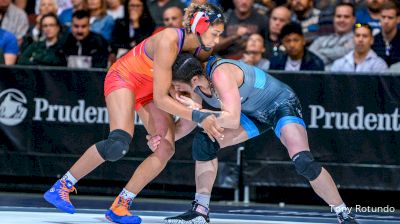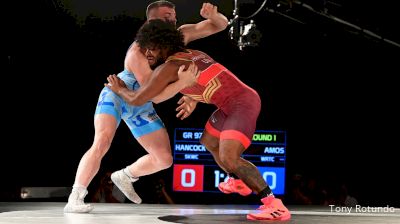What Are The Differences Between Folkstyle, Freestyle & Greco-Roman?
What Are The Differences Between Folkstyle, Freestyle & Greco-Roman?
Explore the differences between three different wrestling styles: folkstyle, freestyle, and Greco-Roman.

Many of the best wrestlers in the United States compete in three uniquely different styles: folkstyle, freestyle, and Greco-Roman.
Folkstyle simply means native style. Some say that the United States is the only country to have folkstyle wrestling, which simply isn’t true. There are hundreds of countries with “folkstyle” wrestling.
Iceland has Glima. Turkey has oil wrestling. Japan has Sumo. Our folkstyle is high school and collegiate wrestling.
Freestyle and Greco-Roman are used for international competitions, namely the World Championships and the Olympic Games.
Freestyle has similarities to our American folkstyle system, while Greco-Roman is uniquely different from the other two.
American folkstyle and freestyle allow leg attacks and Greco-Roman does not. All Greco-Roman attacks must be above the waist. Touching legs in Greco-Roman results in a penalty or a foul.
Taking your opponent off his or her feet and exposing your opponent’s back to the mat is the objective in all three styles.
Think of Greco-Roman as boxing and folkstyle and freestyle wrestling as kickboxing. Boxing only allows strikes to the body and head, while kickboxing allows strikes to the head, body, and legs.
The Differences Between Folkstyle, Freestyle, and Greco-Roman
Folkstyle and freestyle allow leg attacks but there are a variety of differences between the two. The biggest difference is that the American folkstyle system rewards control and freestyle rewards execution.
Freestyle wrestling is just that: a free style of wrestling. Points come faster and matches often end quicker. Folkstyle won’t have as many throws since referees will stop any potentially dangerous moves.
Greco-Roman, as mentioned above, only allows attacks above the waist, which often leads to spectacular throws. This can also lead to low-scoring matches since attacks are limited to half of the body.
Fall/Pin
Securing your opponent’s shoulders to the mat — known as a pin or a fall — is an effective way to end a match. This is universal between all three styles and is the ultimate goal of wrestling. The match ends and a winner is declared once a fall is secured.

Watch scoring highlights from a freestyle match between Kennedy Blades and Adeline Gray
Technical Fall/Technical Superiority
Our American folkstyle system calls it a technical fall, while freestyle and Greco-Roman call it a technical superiority. The concept is the same: outscore your opponent by a specified number of points and the match ends early.
Below is the current point threshold for each style to end a match early.
Folkstyle: 15 points
Freestyle: 10 points
Greco-Roman 8 points

Watch scoring highlights of a Greco-Roman match between G'Angelo Hancock and Braxton Amos
Takedown
All three styles begin with both wrestlers standing. The object is to take your opponent off his or her feet and secure points. A takedown is worth three points in folkstyle, but takedowns can be worth two, four, or five points in freestyle and Greco-Roman depending on how the move is executed.
Near fall and exposure points
Folkstyle wrestling requires the top wrestler to hold the bottom wrestler in a danger position for two to five seconds to secure points (known as a near fall), while freestyle and Greco-Roman require the top wrestler to expose his or her opponent’s back for a split second to score (known as exposure).
Freestyle and Greco-Roman matches can end quickly if a wrestler secures a takedown and earns multiple exposures (worth two points) in sequence. Folkstyle matches require the top wrestler to hold an opponent on his or her back multiple times for multiple seconds to tabulate enough points for a technical fall.
Reversal
Reversals involve stopping an opponent when he or she is in the top position and reversing the situation. A reversal is worth two points in folkstyle and one point in Greco-Roman and freestyle.
Escape
A point is awarded in folkstyle if the bottom wrestler gets out from underneath, faces his or her opponent, and gets to the standing position. There are no escapes in freestyle and Greco-Roman but the referee will stand both wrestlers on their feet after several seconds if neither wrestler scores from par terre (French for on the mat).
Length of matches
Folkstyle matches consist of three periods while freestyle and Greco-Roman consist of two periods with a 30-second break between each. Below is a breakdown with period lengths for each style and age division.
American Folkstyle (college): 3-2-2
American Folkstyle (high school): 2-2-2
Freestyle: 3-3
Greco-Roman: 3-3
U17 Freestyle: 2-2
U17 Greco-Roman: 2-2

Carter Starocci's college folkstyle match during the 2023 NCAA Championship finals ended with a fall
Overtime
Matches will always end after six minutes during freestyle and Greco-Roman matches. Criteria are used to declare the winner if a match is tied at the end of regulation.
Folkstyle matches use an overtime system to declare a winner if matches are tied in regulation.